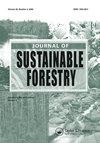毛竹林冠层叶面积指数的估算
IF 1.8
4区 农林科学
Q3 FORESTRY
引用次数: 5
摘要
摘要目前,所有基于间接遥感方法的毛竹林叶面积指数(LAI)地面估算都是基于间接遥感技术进行的。然而,先前研究估计的相对较小的LAI值与如此密集的Moso竹冠层的预期值相冲突。这是首次尝试使用基于破坏性测量的异速测量模型准确估计莫索竹冠层的LAI。结果表明:(1)毛竹林冠层LAI在6.7~30.6 m2·m−2范围内,明显高于以往研究估计的2.2~6.5 m2·m–2范围;(2) LAI与树冠密度呈强线性关系(R2=0.947,RMSE=1.343);(3) 由于对聚集指数的过高估计,使用数字半球摄影(DHP)在很大程度上低估了LAI;(4)叶面积指数与DHP估算的有效叶面积Le呈强指数关系(R2=0.734,RMSE=3.011)。本文章由计算机程序翻译,如有差异,请以英文原文为准。
Estimation of Leaf Area Index of Moso Bamboo Canopies
ABSTRACT All ground-based estimations of leaf area index (LAI) of Moso bamboo canopies are currently conducted based on indirect remote sensing methods. However, the relatively small values of LAI estimated by previous studies conflict with the expected values of such extremely dense canopies of Moso bamboo. This is the first attempt to accurately estimate the LAI of Moso bamboo canopies using an allometric model based on destructive measurements. The results indicate that (1) LAI of Moso bamboo canopies range was 6.7–30.6 m2·m−2, which is clearly higher than the range 2.2–6.5 m2·m−2 estimated by previous studies; (2) there is a strong linear relationship between LAI and crown density (R2 = 0.947, RMSE = 1.343); (3) LAI is largely underestimated using the digital hemispherical photography (DHP) because of the overestimation of clumping index; and (4) there is a strong exponential relationship between LAI and effective leaf area (Le) estimated using DHP (R2 = 0.734, RMSE = 3.011). Based on the results, three methods are recommended for LAI estimations of Moso bamboo canopies using the allometric relationship, the empirical relationship with crown density, and the empirical relationship with Le.
求助全文
通过发布文献求助,成功后即可免费获取论文全文。
去求助
来源期刊

Journal of Sustainable Forestry
Social Sciences-Geography, Planning and Development
CiteScore
3.90
自引率
12.50%
发文量
42
期刊介绍:
Journal of Sustainable Forestry publishes peer-reviewed, original research on forest science. While the emphasis is on sustainable use of forest products and services, the journal covers a wide range of topics from the underlying biology and ecology of forests to the social, economic and policy aspects of forestry. Short communications and review papers that provide a clear theoretical, conceptual or methodological contribution to the existing literature are also included in the journal.
Common topics covered in the Journal of Sustainable Forestry include:
• Ecology, management, recreation, restoration and silvicultural systems of all forest types, including urban forests
• All aspects of forest biology, including ecophysiology, entomology, pathology, genetics, tree breeding, and biotechnology
• Wood properties, forest biomass, bioenergy, and carbon sequestration
• Simulation modeling, inventory, quantitative methods, and remote sensing
• Environmental pollution, fire and climate change impacts, and adaptation and mitigation in forests
• Forest engineering, economics, human dimensions, natural resource policy, and planning
Journal of Sustainable Forestry provides an international forum for dialogue between research scientists, forest managers, economists and policy and decision makers who share the common vision of the sustainable use of natural resources.
 求助内容:
求助内容: 应助结果提醒方式:
应助结果提醒方式:


